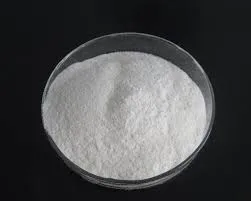
Sep . 21, 2024 17:55 Back to list
hpmc synthesis
HPMC Synthesis An Overview
Hydroxypropyl methylcellulose (HPMC) is a versatile cellulose ether widely utilized in various industries, particularly in pharmaceuticals, food, and construction. Its unique properties stem from its synthesis process, which allows for the modification of cellulose to obtain desired functionalities. This article provides an overview of the synthesis of HPMC, key factors influencing its properties, and its applications.
The Synthesis Process
The synthesis of HPMC involves the treatment of cellulose with propylene oxide and methyl chloride. The process begins with the purification of cellulose, which can be derived from natural sources such as wood or cotton. Once purified, the cellulose is dissolved in a suitable solvent, typically an organic solvent or water under specific conditions.
The next step is the etherification reaction where propylene oxide is introduced to add hydroxypropyl groups. This is followed by the introduction of methyl chloride, which facilitates the incorporation of methyl groups. The reaction is conducted under alkaline conditions, usually using an alkali metal hydroxide as a catalyst. The degree of substitution (DS) of each modification affects the final properties of HPMC, and it can be adjusted by varying the amounts of reactants, reaction time, and temperature.
After the synthesis, the product undergoes purification to remove unreacted materials and by-products. The resulting HPMC is a white to off-white powder that is soluble in cold water, forming a viscous solution. The solubility and viscosity are crucial as they influence the performance of HPMC in its applications.
Properties of HPMC
hpmc synthesis

HPMC exhibits several beneficial properties that make it suitable for a wide range of applications. The modification of cellulose enhances its solubility in water while maintaining its thickening and binding properties. The viscosity of HPMC solutions can be adjusted based on the level of hydroxypropyl and methyl substitution. Additionally, HPMC is non-toxic, biodegradable, and has good film-forming capabilities.
One of its most remarkable properties is its ability to form gels at specific concentrations and temperatures, making it an effective gelling agent. Moreover, HPMC demonstrates excellent water retention and emulsification capabilities, which are valuable in food formulations and pharmaceutical products.
Applications
The versatility of HPMC leads to its use in numerous applications across various fields. In the pharmaceutical industry, HPMC serves as a binder, film-coating agent, and controlled-release agent in tablets and capsules. Its biocompatibility and non-toxic nature make it suitable for use in drug delivery systems.
In the food industry, HPMC is employed as a thickener, stabilizer, and emulsifier. It is particularly useful in gluten-free products, where it enhances texture and moisture retention. In the construction sector, HPMC is utilized in cement and plaster formulations to improve workability and water retention.
Conclusion
HPMC synthesis is a well-established process that results in a multifunctional polymer with wide-ranging applications. The ability to tailor its properties through specific modifications makes HPMC a crucial ingredient in several industries. As the demand for sustainable and efficient materials grows, the importance of HPMC in various sectors will likely continue to rise, underscoring the significance of its synthesis in modern applications.
-
Versatile Hpmc Uses in Different Industries
NewsJun.19,2025
-
Redispersible Powder's Role in Enhancing Durability of Construction Products
NewsJun.19,2025
-
Hydroxyethyl Cellulose Applications Driving Green Industrial Processes
NewsJun.19,2025
-
Exploring Different Redispersible Polymer Powder
NewsJun.19,2025
-
Choosing the Right Mortar Bonding Agent
NewsJun.19,2025
-
Applications and Significance of China Hpmc in Modern Industries
NewsJun.19,2025







